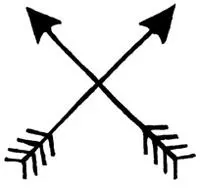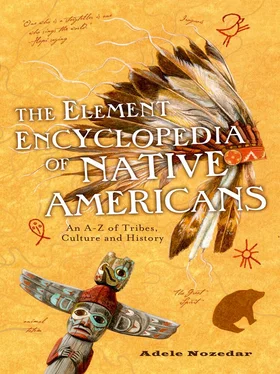A weapon used to catch or hinder an animal (or person) when it was hurled at the legs of the prey. The bola consisted of rocks or stones attached to lengths of sinews or thongs, the whole attached to a longer length of rope. The bola hobbled the prey, enabling it to be captured easily.
Likely to be a European word, since “booger” has the same origins as “boogeyman” or “boggart,” the booger mask was in particular a Cherokeeartifact, a mask carved of wood with exaggerated, cartoonlike features, often resembling animals or human/animal hybrids.
The traditional image of a Native American would not be complete without the classic weaponry of the bow and arrow. We know that the use of the bow and arrow was widespread among the indigenous people of America from about A.D. 500, and that it’s likely the weapon arrived in America around 2500 B.C., from the Arctic.
It was very important that the main shaft of the arrow was as straight as possible. The pithy canes used for these shafts were selected with care, and hung in bundles above a fire—the central fire in a tipiwas ideal—to further straighten and season them. Afterward, the shafts were smoothed and polished with stone tools. Initially intended for huntinganimals, a shallow groove would be carved along the length of the arrow so that, once the arrow had pierced its target, the animal’s blood would continue to flow along this groove, not only weakening the prey as it lost blood but also enabling the hunter to track the animal as the blood splashed the ground.
The “flight,” or feathered end of the arrow, was actually made from feathersand helped the weapon fly through the air. In the main, feathers from the wild turkey or the eaglewere preferred, and of these birds, the wing feathers were best for the purpose. Using feathers from the same wing meant that the arrow had a twisting, spiraling flight pattern. Most arrows had three feathers fixed to them, set at regular intervals around the end of the shaft. These feathers were fastened with glue(probably made from ground bones) and further strengthened with sinew tied around them.
The actual arrowhead could be made from a number of different materials: knapped flint, copper, bone or horn, or the tips of antlers. The coming of the white man meant that iron was introduced to the Natives, and so this metal was used to make arrow tips, too.
Hunting arrows did not have the distinctive barbed shape that’s often seen; this meant that the arrow could be removed easily from the animal. However, arrows that were intended for use in war were complete with the barb, which made them almost impossible to remove without doing further damage to the enemy. The barbs of these arrows were sometimes tied to the shaft quite loosely so that there was more chance of them remaining painfully embedded in the flesh of the victim.
Different tribes preferred slightly different types of arrow; experts can differentiate these sometimes subtle distinctions. Plains tribes, for example, liked a short arrow with a long feather. Native peoples also marked their own arrows so that they were identifiable. It was always good to know without a shadow of a doubt whose blow had killed the enemy.
Any kind of springy, whippy wood—hickory, cedar, mulberry, white ash, or dogwood—could be used to make a bow; so, too could horn or bone. Bows were made in many different sizes and shapes, to suit the user. His bow was a precious tool to any Native American, and he continued to carry it even after the coming of guns.
There were different types of bow, too. The simplest was called the “self bow,” made from one piece of wood and strengthened with sinew glued and lashed along its length. Then there was the “compound bow” made from layers of materials such as wood, bone, and horn, glued and lashed together with sinews. There was a bow whose wooden part was entirely wrapped in sinew. The Eskimo actually made bows from the rib bones of whales.
In the same way that different tribes preferred different types of arrows, they also preferred different styles of bow. For example, the Plains Indians preferred a shorter bow since they would be likely to use it when on horseback. The Apachebow had its tips curved back, like the typical “Cupid’s bow.” The Pueblomade miniature bows, painted them, and buried them with their dead.
The bowstring itself, which pulled back the arrow to make it fly, was generally made from twisted vegetable fibers, rawhide, and sinew. It was important that the bowstring had “bounce” and elasticity combined with toughness; bear guts or other animal guts were ideal for this purpose, since this material had the necessary qualities. One end of the bow string was affixed to the wooden part of the bow permanently, while the other was loose when not in use, attached only to a notch in the bow when the weapon was about to be used. This meant that the bowstring itself lasted longer and wasn’t overstretched.
The Native American, no matter his tribe, was incredibly skilled with his bow and arrow, and legendarily could fire off half a dozen arrows in the time it took the white man to load one bullet into the early single-shooter guns.

“The Mohawks have on all occasions shown their zeal and loyalty to the Great King; yet they have been very badly treated by his people.”
1743–1807
“Joseph Brant” was the name given by the Europeans to the Mohawkleader Theyebdabegea (meaning “two sticks tied together for strength”). Joseph was born in Ohio Country into the Wolfclan of his mother—it was the practice among matrilinealtribes, as the Wolf were, for the child to belong to its mother’s people.
Joseph’s father died before he was ten, at which point his mother moved back to a Mohawk village in the New York area with her son and his elder sister Molly. Shortly afterward, his mother married a Mohawk chief named Canagaraduncka, who also carried the name of Brant. Brant’s family had strong connections with the British, his father being one of the Four Mohawk Kingswho actually visited Britain in 1710. The family were relatively wealthy, although none of the lineage of his stepfather was passed on to the young Joseph because of that matrilineal line.
Joseph’s new stepfather had a good friend, Sir William Johnson, a very influential man who was the Superintendent of Indian Affairs in the area. Joseph’s sister Molly and Johnson got to know one another, since Johnson spent a lot of time at the house, and the two subsequently married.
Sir William Johnson, now Joseph’s brother-in-law, took an interest in the young Mohawk, to the point of supervising his education. Joseph was sent with two other Mohawk boys to a school that would later become Dartmouth College. A clever boy, he was a quick study and was schooled in Latin and Greek as well as English. Like other Native American boys, Brant was introduced at an early age to the arts of warfare, and had followed Sir William into battle at the tender age of 13 during the French and Indian Wars. After this excitement, he returned to school.
It’s certain that Joseph was a talented linguist, and it has been suggested that he was fluent in all six of the Iroquois Confederacylanguages—an extremely valuable asset. Because of his language skills and the fact that he had adopted the Christian faith, Brant acted as an interpreter for a Christian missionary named Reverend John Stuart; their work together resulted in the translation of the Gospel of Mark, and the common prayer book, into the Mohawk language. In later life Joseph would translate more Christian works.
Читать дальше













